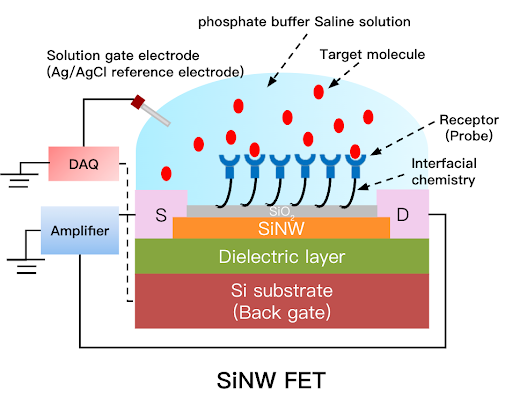
Traditional diagnostic methods, like PCR, often struggle with speed and sensitivity, making early disease detection challenging. Delayed or inaccurate results can lead to missed treatment opportunities and poor outcomes. This article explores how SiNW-FET chips are transforming biosensing with ultra-sensitive, real-time detection for healthcare, environmental monitoring, and beyond.
Imagine an FET biosensor so small yet so powerful that it can detect diseases at their earliest stages or monitor environmental toxins with pinpoint accuracy. That’s exactly what Silicon Nanowire Field-Effect Transistor (SiNW-FET) chips bring to the table.
Silicon nanowire field-effect transistor (SiNW-FET) biosensors are cutting-edge semiconductor biochips that enable ultra-sensitive, real-time, and label-free detection of biomolecules. By using silicon nanowires as the channel material, the SiNW-FET System achieves exceptional precision while remaining compatible with existing silicon fabrication processes. Their high specificity and ability to detect biomolecules at ultra-low concentrations make them invaluable for a wide range of applications.
SiNW-FETs function as ultra-sensitive biological switches that convert molecular interactions into electrical signals. Their key advantage lies in the SiNW-FET surface, which is precisely engineered with specific biological receptors—such as antibodies, enzymes, or DNA—to detect target molecules like viruses, proteins, or pollutants.
When target molecules bind to these receptors, they alter the local electrical charge around the silicon nanowire. This change impacts the current flow between the source and drain electrodes, providing immediate, label-free, and quantifiable detection.

So, how are these powerful biosensors made? There are two main fabrication methods, each with its own advantages:
SiNW-FET chips have emerged as groundbreaking tools in the field of biosensing, offering a multitude of advantages.
One of the most remarkable features of SiNW-FET chips is their ultra-high sensitivity. The unique structure of silicon nanowires provides an exceptionally high surface-to-volume ratio, enhancing their ability to detect minute changes in their environment. This characteristic enables the detection of low concentrations of biomolecules, making SiNW-FETs invaluable in early disease diagnosis and monitoring.
SiNW-FET chips excel in providing real-time detection capabilities. Their design allows for the immediate transduction of biological interactions into electrical signals, facilitating continuous monitoring without the need for time-consuming labeling processes. This real-time functionality is crucial in applications requiring prompt responses, such as monitoring rapid biological processes or detecting environmental toxins.
The architecture of SiNW-FETs supports multiplexing, allowing for the simultaneous detection of multiple targets. By fabricating arrays of nanowires and selectively functionalizing each with different receptors, these sensors can analyze various analytes concurrently. This multiplexing capability enhances the efficiency of diagnostic procedures and is particularly beneficial in comprehensive screenings where multiple biomarkers need to be assessed simultaneously.
SiNW-FET chips can be designed for reusability through reversible surface functionalization methods. This feature not only reduces operational costs but also aligns with sustainable practices by minimizing waste. The ability to regenerate the sensor surface without compromising sensitivity or specificity ensures that SiNW-FETs remain functional over multiple cycles of detection, making them practical for long-term applications.
SiNW-FET chips have emerged as powerful biosensing tools due to their ability to detect biomolecules at extremely low concentrations. Their high sensitivity and real-time detection capabilities make them invaluable across multiple fields, including medical diagnostics, pharmaceutical development, and scientific research.
In medicine, SiNW-FETs are revolutionizing disease detection by enabling rapid and accurate diagnostics. By detecting antigen-antibody interactions or nucleic acid hybridization, they can identify viral and bacterial pathogens, demonstrating strong potential for early disease detection.
Beyond diagnostics, SiNW-FET biosensors play a crucial role in pharmaceutical research and drug development. Their ability to monitor protein interactions, such as antibody-antigen binding, provides critical insights into disease mechanisms and therapeutic efficacy. This capability is essential for developing targeted treatments and improving drug discovery and therapy processes.
In academic and scientific research, SiNW-FET biosensors are widely used to study molecular interactions and cellular processes. They facilitate the study of neurotransmitters and the detection of adenosine triphosphate (ATP) released from living cells, making them indispensable tools for neuron research and brain studies. Their ability to track biochemical activities in real-time provides researchers with a deeper understanding of fundamental biological processes, advancing knowledge in life sciences.
With their ultra-high sensitivity, real-time detection, and multiplexing capability, SiNW-FET chips are driving the advancement of biosensing technologies. Their integration into diagnostic and monitoring platforms promises more efficient, accurate, and cost-effective solutions across healthcare, environmental monitoring, and other critical fields.
Molsentech is transforming the future of diagnostics with our groundbreaking BioFET Chip platform. As a trailblazing biotech startup from Taiwan, we merge advanced semiconductor biochip technology with proprietary surface modification techniques, seamless system integration, and AI-driven analytics to deliver fast, precise, and reliable results. Our technology has already made a significant impact during the COVID-19 pandemic and is now paving the way for early detection of Alzheimer’s, cancers, and emerging infectious diseases.
Innovation in biosensing is accelerating—are you ready to lead the way? Whether you’re in healthcare, research, or industry, our BioFET solutions provide the accuracy and speed you need to make a difference. Let’s collaborate to revolutionize diagnostics, improve patient outcomes, and drive the next wave of medical breakthroughs. Contact us today and be part of the future of detection and disease prevention.
What is POCT (Point-of-Care Testing): Benefits, Examples, and More
What is a Microfluidic Chip: How It Works, Fabrication, and More
What is Bio-FET Chip: How it Works, Benefits, Applications
What is Nanopore Sequencing Technology: Uses, Benefits & Trends

Smart diagnostics made simple — ultra-sensitive, lightning-fast, scalable, and effortless to use.
+886-2-2783-5173
support@molsentech.com
© 2025 Molsentech. All Rights Reserved.